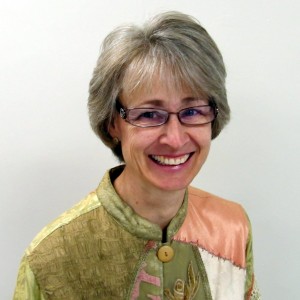The South East Inter Branch Council (SEIBC) of AAUW assembled on Saturday, March 31, at Habitat for Humanity, 2180 Iowa Ave., at 9:30 AM for their quarterly session.
After a brief explanation of the meaning and purpose of SEIBC to our guests, Jo Turner, President, introduced Dr. Marylynn Yates, Dean of the College of Natural and Agricultural Sciences at UCR, as our speaker. Dr. Yates has had an illustrious career at UCR – recipient of UCR’s Distinguished Teaching Award in 2001-02, and being named Distinguished Teaching Professor in 2006. She is the first woman to be selected as Dean of her Department.
Dr. Yates’ research focuses on the transmission of diseases in water. There are micro-organisms in the environment, and many of these interact. The Center for Disease Control issued a report that summarized all of the waterborne diseases that were reported in 2007-08 and identified the causes of nearly 90% of the cases. One problem is that not all cases are reported – lots of them are not. However, since 1971 the trend of outbreaks is going down. It is well to remember, that to be considered an outbreak, at least two people must get sick from drinking the water. Many outbreaks arise from drinking water that causes acute gastro-intestinal illnesses. (She cited one exception, a particular amoeba that enters the nose, begins like meningitis, progresses to hallucinations, paralysis and then death in seven days — a case not-so-long ago at Lake Elsinore.
The vast majority we are concerned with are enteric-pathogens. The patient gets gastro-enteritis which can be serious – such as polio, water borne hepatitis A virus, (eating raw oysters) and the hepatitis B virus. Enteric pathogens organize in your intestinal tract and multiply and are the causes of fecal transmission of diseases. The following are some examples.
- E-coli is naturally present in our intestinal tract — we could not survive without it. Some strains cause diseases such as bloody diarrhea, or kidney failure.
- Salmonella is commonly found in eggs or chicken, and it also causes diarrhea, or typhoid.
- Shigella is usually associated with swimming water and causes diarrhea and fever.
- Giardia is a parasite found in the small intestine and causes diarrhea, cramps, and nausea that can last a month. There are antibiotics to treat this.
- Cryptosporidium causes diarrhea especially in people whose immune system isn’t functioning well. This caused a wake up call for public health and the medical establishment in 1993 in Milwaukee. 400,000 people were ill, 4,000 were hospitalized, and over 100 died. The source of the pathogen was a commercial ice maker. (Cow manure had washed into Lake Michigan and the pathogen in the manure overwhelmed the treatment plant.) Interestingly, the first people to take note of the illness were the student clerks who couldn’t keep the drugstore shelves stocked with anti-diarrhea medications.
- Rotavirus is the most common cause of severe diarrhea in the world — especially in the developing world. Patients can become dehydrated very easily. It causes one million deaths a year worldwide. Why does this pathogen concern us in the U.S? We have 2.7 million cases a year and this causes huge economic losses in absences from school and work and also the number of doctor visits that result. There is a vaccine for it, but it is costly, — $200.00 for three doses. (This, of course, is too expensive for developing countries.) By the time children are five, they have developed an antibody for it.
- Norovirus causes diarrhea and vomiting. The outbreaks are often on cruise ships.
- Hepatitis A Virus causes liver infection.
- Legionella grows in stagnant water and can cause pneumonia. There was an outbreak in Philadelphia in 1976 which spread through the area.
Dr. Yates took this opportunity to give a definition of diarrhea. Diarrhea is caused when food moves too quickly through your body and can’t take the water from the food. Hence, the dehydration.
This leads to the question – how do these pathogens get into our water? Pathogens get into our water because animal waste and human waste are used as fertilizer. (Organic foods can be fertilized with animal waste.) In general, the waste materials degrade while moving through the soil, however, viruses are tiny and can get through the soil and into the ground water. Viruses can live for months but the number of viruses that cause you to get sick vary from organism to organism. Should we worry about this contamination? Waste water is treated, it’s not sterile, but it is cleaner. We regulate our drinking water – we have lots of standards.
What is of concern is the global disease burden. The developing countries have 2.1 million deaths annually from diseases. Ten percent of the people in less industrial societies have tapeworms, all of this because of the lack of proper waste management.
Dr. Yates’ presentation was a visual and auditory learning experience for those of us privileged to attend. Because of her vast knowledge and the ease and grace of her instruction on this very current world-wide environmental-medical issue, we felt wiser and very fortunate. Dr. Yates is a gifted woman of Science. We celebrate that, and are grateful that she shared so much with us.
Jo Turner, President of SEIBC, was pleased to inform Dr. Yates of AAUW’s Tech Trek program for middle school girls to attend a one week summer camp to become better acquainted with the STEM subjects and hopefully, retain that interest and choose a STEM subject as a major in their later education. Dr. Yates gave a positive response. She feels that she’s had a unique experience — the first woman hired in her department, 1987, first department chair, and first Dean. Her closest colleagues are men. A group at UCR, with funds from the National Science Foundation, mentors junior women faculty in the STEM fields. Lots of women feel isolated. Dr. Yates believes it’s vital to get girl students early, and then into a lab where they can do some science research and have a personal relationship with the faculty.
Before she packed up to leave, Dr. Yates told us a little about the long road she has taken in her life. She was the first of her family to attend college and went to the U. of Wisconsin. She began as an engineering major, changed to nursing, and graduated after a five year plan. She got married and followed her husband to New Mexico where he was getting his Master’s Degree. She was a nurse, but she was bored. She quit her job, went back college, got her Master’s in Chemistry and decided on a PhD at N. Mexico Tech. However, plans changed, she and her husband both got into a PhD program at U. of Arizona. Her first job was in Ada, Oklahoma with the USEPA, but Ada, Oklahoma was not as enticing as UCR where both she and her husband came in 1987. She and her husband have two children, and she states that having a supportive husband has been an enabling factor all the way through her life in academia.

